


(DR) SAMUEL JOHNSON 1709 -
(AN, G1, G2, G3a, G3b)
xxxxxAs we have seen, for Samuel Johnson, fame came in 1755 (G2) with the publication of his brilliant Dictionary. In this reign he is best remembered for his edition of Shakespeare’s plays and, above all, for his Lives of the English Poets, the biographies of no less than 52 poets. These pulled no punches, either on the quality of their lives or their poetry, and they were particularly notable for their independence of thought and their accurate recording of the smallest character trait. But he was not only a critic, author and lexicographer. Indeed, he excelled above all as a conversationalist, be it amongst his learned friends at a club or dinner party, or airing his views in some back-
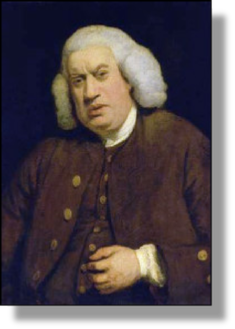 xxxxxAs we have seen, in his early days, the English man of letters, Samuel Johnson, made his living as a hack writer. He wrote numerous articles and reports of parliamentary debates for the Gentleman’s Magazine, for example, and then went on to produce his own publications, The Rambler and The Idler. Worthyxof special mention during this period is the sympathetic biography of his wayward friend the poet Richard Savage (c1697-
xxxxxAs we have seen, in his early days, the English man of letters, Samuel Johnson, made his living as a hack writer. He wrote numerous articles and reports of parliamentary debates for the Gentleman’s Magazine, for example, and then went on to produce his own publications, The Rambler and The Idler. Worthyxof special mention during this period is the sympathetic biography of his wayward friend the poet Richard Savage (c1697-
xxxxxBut, as noted earlier, Johnson was not just an accomplished critic, author and lexicographer. Nothing pleased him more than when he was in conversation (mostly his conversation!), be it amongst the learned at a dinner party or club, or “holding forth” in some back-
 xxxxxMeanwhile, having received a government pension in 1762 and escaped the poverty trap, Johnson embarked upon another major enterprise, an edition of Shakespeare’s plays. Produced in 1765 after some delay, this scholarly work in eight volumes attempted to gain insight into the bard’s aims and motives, defending him as a “poet that holds up to his readers a faithful mirror of manners and of life”. The text is well annotated, and his preface continues to be regarded as a masterly piece of literary criticism. In the same year -
xxxxxMeanwhile, having received a government pension in 1762 and escaped the poverty trap, Johnson embarked upon another major enterprise, an edition of Shakespeare’s plays. Produced in 1765 after some delay, this scholarly work in eight volumes attempted to gain insight into the bard’s aims and motives, defending him as a “poet that holds up to his readers a faithful mirror of manners and of life”. The text is well annotated, and his preface continues to be regarded as a masterly piece of literary criticism. In the same year -
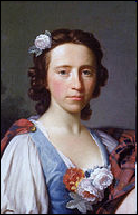 xxxxxIndeed, it was while working on this edition that in 1763 he met the young Boswell, then 22, and they struck up a friendship which lasted for over 20 years. Out of it came one of literature’s greatest biographies, the Life of Samuel Johnson, a work based on careful observation of Johnson’s activities and verbatim recordings of his conversations. Boswell never lost an opportunity to study his much-
xxxxxIndeed, it was while working on this edition that in 1763 he met the young Boswell, then 22, and they struck up a friendship which lasted for over 20 years. Out of it came one of literature’s greatest biographies, the Life of Samuel Johnson, a work based on careful observation of Johnson’s activities and verbatim recordings of his conversations. Boswell never lost an opportunity to study his much-
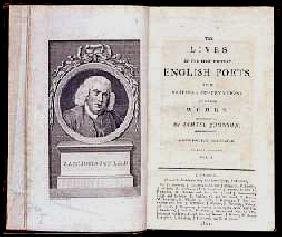 xxxxxHis last major work, and probably his finest contribution to English literature, was the classic The Lives of the English Poets. It was begun in 1778 and, running to ten volumes, was not completed until 1781. It ended up as a set of critical biographies of no less than 52 English poets, from Abraham Cowley to Thomas Gray. Each biography was divided into three clearly defined parts -
xxxxxHis last major work, and probably his finest contribution to English literature, was the classic The Lives of the English Poets. It was begun in 1778 and, running to ten volumes, was not completed until 1781. It ended up as a set of critical biographies of no less than 52 English poets, from Abraham Cowley to Thomas Gray. Each biography was divided into three clearly defined parts -
xxxxxDuring the 1770s, it should be noted, Johnson produced a number of political pamphlets supporting the government. His The False Alarm of 1770 strongly supported the House of Commons’ decision not to readmit the member of Parliament John Wilkes (found guilty of libel), and another, written the following year, came out strongly against a war with Spain over the Falkland Islands, that “tempest-
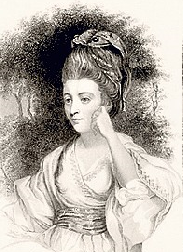
xxxxxJohnson was, without doubt, the leading writer and scholar of his day. However, his outstanding literary talent aside, he was not always an easy man to get along with. He could be extremely irritable, overbearing, self-

xxxxxIncidentally, during his visit to Scotland, Johnson was pleased to discover that the Highlanders were willing to drink the loyal toast to the King. Wisely no doubt, Boswell felt it best not to tell him that it was their custom, when making the toast, to pass their wine glass over a glass of water, thereby drinking to the Stuart king in exile “across the water”!
Acknowledgements
Johnson: by the English portrait painter Sir Joshua Reynolds (1723-
G3a-
Including:
Fanny
Burney

xxxxxFanny Burney (1752-
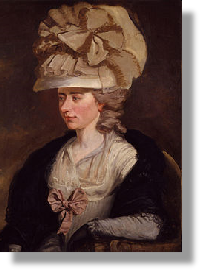 xxxxxA prominent member of Johnson’s literary circle was the novelist and diarist Fanny (Frances) Burney (1752-
xxxxxA prominent member of Johnson’s literary circle was the novelist and diarist Fanny (Frances) Burney (1752-
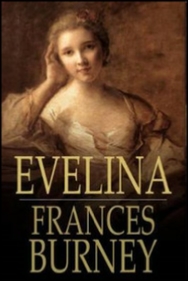 xxxxxHer first novel Evelina (or The History of a Young Lady’s Entrance Into the World) was published anonymously in 1778 and caused a stir. Centred around a young girl’s innocent uncertainty as to the behaviour expected of her in polite society, it broke new ground in the genre of the elegant novel of manners, paving the way for the celebrated heroines created by the English novelist Jane Austen. And once the identity of the author had leaked out, the quiet, unassuming Miss Fanny became the talk of the town. She was introduced to London’s literary circles by the society hostess Mrs Hester Thrale, and she was soon mingling with the members of Johnson’s prestigious Literary Club. Her novel was warmly praised by many persons of distinction, including Samuel Johnson himself, the painter Joshua Reynolds, the politician Edmund Burke, and perhaps most significantly, the writer Horace Walpole.
xxxxxHer first novel Evelina (or The History of a Young Lady’s Entrance Into the World) was published anonymously in 1778 and caused a stir. Centred around a young girl’s innocent uncertainty as to the behaviour expected of her in polite society, it broke new ground in the genre of the elegant novel of manners, paving the way for the celebrated heroines created by the English novelist Jane Austen. And once the identity of the author had leaked out, the quiet, unassuming Miss Fanny became the talk of the town. She was introduced to London’s literary circles by the society hostess Mrs Hester Thrale, and she was soon mingling with the members of Johnson’s prestigious Literary Club. Her novel was warmly praised by many persons of distinction, including Samuel Johnson himself, the painter Joshua Reynolds, the politician Edmund Burke, and perhaps most significantly, the writer Horace Walpole.
xxxxxBurney later wrote three other novels, Cecilia in 1782, Camilla in 1796 and The Wanderer, published in 1814. All followed the same sentimental theme, and the first two made money, but none managed to achieve quite the same impact and spontaneity of her first work. And in addition to her writing, she spent five years at court as keeper of the robes to Queen Charlotte. She resigned in 1791 and two years later married the French royalist in exile, General Alexandre d’Arblay.
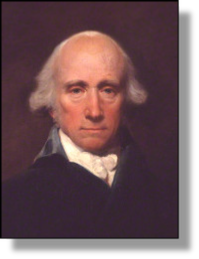 xxxxxBut Fanny Burney’s fame (or Madame d’Arblay’s fame) does not rest solely on her work as a novelist, far from it. Today, she is remembered above all for the diary she kept for 71 years. During her early days in London she was supported in her hopes of a literary career by Samuel Crisp, one of her father’s friends. It was to "Daddy Crisp" that her first letters were addressed. Beginning in 1768, they included accounts of the musical evenings held by her father and the celebrities who attended them, her plans to write a novel, and the satisfaction she felt on finding unexpected fame. It is to her credit that, while working at court she made no reference to the gossip surrounding the king’s mental state, but she did cover a number of public events, including the trial of the colonial administrator Warren Hastings (illustrated). Published posthumously in two parts, these journals provided a fascinating series of pen-
xxxxxBut Fanny Burney’s fame (or Madame d’Arblay’s fame) does not rest solely on her work as a novelist, far from it. Today, she is remembered above all for the diary she kept for 71 years. During her early days in London she was supported in her hopes of a literary career by Samuel Crisp, one of her father’s friends. It was to "Daddy Crisp" that her first letters were addressed. Beginning in 1768, they included accounts of the musical evenings held by her father and the celebrities who attended them, her plans to write a novel, and the satisfaction she felt on finding unexpected fame. It is to her credit that, while working at court she made no reference to the gossip surrounding the king’s mental state, but she did cover a number of public events, including the trial of the colonial administrator Warren Hastings (illustrated). Published posthumously in two parts, these journals provided a fascinating series of pen-
xxxxxIn 1797, on the proceeds of her novel Camilla, she moved with her husband to a house in Surrey, but, whilst on a visit to France with her husband and son in 1802, they were caught up in the start of the Napoleonic Wars, and were obliged to stay on the continent until after the Battle of Waterloo in 1815. The family then returned and settled in Bath but, following the death of her husband in 1818, she retired to London and gave time to the publication of her father’s memoirs.
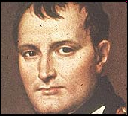 xxxxxIncidentally, while in France she attended one of Napoleon’s receptions and caught a glance of the great man himself. She wrote, later: “I had a view so near, though so brief, of his face, as to be deeply struck by it….. He has by no means the look to be expected of Bonaparte, but rather that of a profoundly studious and contemplative man. ….. The plainness, also of his dress, so conspicuously contrasted by the finery of all around him, conspires forcibly with his countenance … to give him far more the air of a student than a warrior.”
xxxxxIncidentally, while in France she attended one of Napoleon’s receptions and caught a glance of the great man himself. She wrote, later: “I had a view so near, though so brief, of his face, as to be deeply struck by it….. He has by no means the look to be expected of Bonaparte, but rather that of a profoundly studious and contemplative man. ….. The plainness, also of his dress, so conspicuously contrasted by the finery of all around him, conspires forcibly with his countenance … to give him far more the air of a student than a warrior.”


